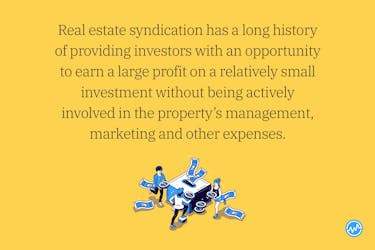

Get Access to 250+ Online Classes
Learn directly from the world’s top investors & entrepreneurs.
Get Started NowIn This Article
- What is Real Estate Syndication?
- How Does Real Estate Syndication Work?
- 506(C) Vs. 506(B) Syndication
- How Investors Profit in Syndications
- Benefits of Real Estate Syndication
- Drawbacks of Real Estate Syndication
- Real Estate Syndication vs. Crowdfunding: What’s the Difference?
- A Real Estate Syndication Example
- Real Estate Syndication Books
- Getting Started: Real Estate Syndication
- Is Real Estate Syndication Right for You?
Do you want to invest in real estate, but you don’t have the time or desire to find a property, deal with tenants, or rehab a house?
If you don’t want to manage these aspects of real estate investing, but you still want the benefits that real estate investing offers, there are several other unique, proven and profitable forms of real estate investing.
One of these is known as real estate syndication.
What is Real Estate Syndication?
Long before crowdfunding became a viable option for real estate investing and business startups, real estate syndication was operating under the same general premise.

If you choose real estate syndication as your method of real estate investing, you will be pooling your money with other investors to purchase an investment property under a real estate syndication sponsor.
Real estate syndication isn’t relegated to a single type of property. It includes investing in:
- Fix and flip
- Rentals
- Apartments
- Commercial property
- And more
How Does Real Estate Syndication Work?
In the world of real estate syndication, there are two roles that must be filled: the syndicator, who is often referred to as the “sponsor” of the investment, and the investor.
The syndicator is often a company comprised of real estate investors with high level real estate experience and education.
Because many investors don’t have the time to scout out properties, the syndicator is responsible for scouting out potential investment properties and conducting the market research.
Investors put capital into the property to help secure the purchase and cover the monthly expenses associated with owning an investment property.
The syndicator generally doesn’t put much capital into the real estate syndicate. Instead, they take on the role of:
- finding the property
- securing it through a contract
- may even handle the daily management responsibilities
- keeps investors informed on property updates
Real Estate Syndication: The Investor
In a real estate syndication, investors provide the majority of the funds necessary to purchase and manage real estate assets.
They act as passive partners and are not involved in the routine management of the properties.
506(C) Vs. 506(B) Syndication
Regulation D of the Securities Act regulates how real estate investors can raise capital. This regulation includes two different rules:
- 506(B)
- 506(C)
In a 506(B) syndication, real estate investors and developers are allowed to raise an unlimited amount of money from an unlimited number of accredited investors and up to 35 non-accredited investors without needing to file with the Securities and Exchange Commission (SEC) ahead of time.
However, keep in mind that general solicitation is not allowed: issuers must have an established relationship with the investors prior to the offering.
This is compared to Rule 506(C) syndications, which are more recent and were established in 2012 following the JOBS Act. They allow general solicitations, but non-accredited investors are not permitted to participate in the offering.
There is no limit on the amount of money that can be raised, or on the number of accredited investors who can take part.
How Investors Profit in Syndications
A real estate investor who chooses to put his or her money into a syndication receives a percentage of the profits at the designated payout points, often quarterly.
For instance, if your initial investment is equal to four of the quarterly payouts, you would begin earning a profit with the fifth payout.
If you invest in a fix and flip property that pays out when the property sells, you will earn a percentage of the profits based on the percentage that you invested on the front end of the deal.
Or, if it’s a rental property, an investor may receive monthly or quarterly dividends.
Benefits of Real Estate Syndication
There are benefits for both the sponsor and the investor when dealing with real estate syndication.
Access to a diversified portfolio
Real estate syndications allow investors to invest in assets — particularly commercial properties — they could not access individually.
By purchasing a smaller share, they can diversify their portfolio and spread the risks.
They can also benefit from the higher returns this type of property can typically yield.
Benefit from well-experience help
Commercial real estate investing has a steep learning curve.
By joining a real estate syndication, investors get access to the expert knowledge of the sponsor as well as the other investors.
Passive income
Some forms of real estate investing are very involved and can be difficult to manage for an investor with a full-time job.
On the other hand, real estate syndications can create a stream of passive income and allow investors to take the backseat.
Invest what you are comfortable with
Investors can benefit from real estate syndicates because they only put up as much money as they’re comfortable with, though there often is a minimum requirement to buy in.
Because of the experience of the syndicator and the amount of cash an investor puts up, the risk for real estate syndication can decrease.
Drawbacks of Real Estate Syndication
There are several drawbacks of real estate syndication that investors need to be aware of, including:
Property Failure
Investors who invest in a majority of the funds for the property are subjected to serious financial risk if the property fails.
Even if they recoup some of their money from the personal recourse guarantee, they still stand to lose a significant amount.
Investors in commercial properties stand to lose money if there are long-term vacancies in the subject property or if the operating expenses outweigh the revenue the property generates.
Real Estate Syndications are not liquid
Although real estate syndications provide consistent compounding returns, your initial investment money is frozen for a specific time — for example, five to seven years — depending on the length of the deal.
This can become an issue if you suddenly need immediate liquidity since, unlike stocks or even other real estate assets that can be sold if needed, you cannot get access to your money.
Lack of control over the deal
Although most investors appreciate the lack of involvement in the daily running of the operations, some people can find the absence of control difficult to handle.
It demands a significant amount of trust in the investment and decision-making skills of the sponsor.
Hidden fees
Real estate syndications include numerous fees and additional costs that can be difficult to understand.
Some of these fees are a one-time fee, while others are recurring.
These expenses can include:
- organization and due diligence fee (or Acquisition fee),
- asset management fee,
- property management fees,
- And more
Real Estate Syndication vs. Crowdfunding: What’s the Difference?

While many people think that syndication is just another form of crowdfunding, that is simply not the case.
Real estate syndications are a funded relationship between a group of investors and the syndicator while crowdfunding is simply a method of finding investors.
Non-accredited investors can participate in a crowdfunding campaign while many syndicates only open to accredited investors.
Crowdfunding-based investments typically offer less transparency, which means investors aren’t as informed about what their money is doing for the property.
Conversely, syndicates allow the investors to fully vet the sponsor to ensure that he or she is someone that they’re comfortable investing in.
A Real Estate Syndication Example
To better understand how real estate syndications can be profitable, let’s look at a simple example.
Let’s assume that a syndicator presents you with an opportunity to invest in a fix and flip property. The property’s purchase price and rehab costs total $100,000.
You don’t have the funds to purchase the entire property yourself, but you can invest 10% or $10,000. You now own 10% of the property and will be entitled to 10% of the profits.
The property soon sells for over $200,000. Assuming that once the property has sold and all closing costs, realtor fees and other expenses have been paid, the property nets $180,000.
Since you own 10% of the property, you’re entitled to 10% of the profits which earns you $18,000.
Once you account for the initial investment of $10,000, you profited $8,000 passively from the deal.
Real Estate Syndication Books

If you want to learn more about real estate syndication, here are a few easy to purchase real estate syndication books.
The Hands-Off Investor: An Insider's Guide to Investing in Passive Real Estate Syndications
One of the most crucial parts of real estate syndication is finding the right sponsor.
But what qualities should you look for in a sponsor?
Where should you look?
Who should you trust?
“The Hands-Off Investor: An Insider's Guide to Investing in Passive Real Estate Syndications” provides answers to this — and much more.
In this real estate syndication book, you’ll learn how to successfully invest in real estate “without tenants, toilets, or trash” — even if you have no previous real estate investing experience.
In this real estate syndication book, you’ll also learn:
- Red flags to avoid and tricks that syndication sponsors don't want you to know
- The tax implications of syndication investments
- How to measure alignment of interest, judge performance projections,
- and more
You can buy this real estate syndication book here.
The Best Ever Apartment Syndication Book
If you want to invest in apartments, but lack experience, capital or the skills to create a business plan, “The Best Ever Apartment Syndication Book” can help.
In the real estate syndication book, readers can learn how the author went from making a $30,000 salary at a 9-5 job to controlling over $572,000,000 in apartment communities!
In this real estate syndication book, you can also learn how to:
- Become an expert on the apartment syndication terminology
- Build a powerful brand that attracts passive investors
- Prepare and present an apartment offering to your passive investors and securing financial commitments
- And more
You can buy this real estate syndication book here.
Getting Started: Real Estate Syndication
So how can you get started in your first real estate syndication deal? Let’s take a look.
Step 1: Decide on how much you want to invest
Since the bulk of the money will be frozen for the next five to seven years, you will need to decide how much you can comfortably invest in real estate syndication.
Make a list of your mid-term goals and calculate your living expenses, including any additional savings you may need along the way to cover emergencies.
The amount of money you can invest will also determine which real estate syndications you can have access to.
Step 2: Find the right real estate syndication
Investing in a real estate syndication requires a high level of trust in the sponsor’s capabilities. It’s imperative that you make sure that they are experienced and have an excellent track record.
You should also carefully examine the documents offered by the sponsors (executive summary, full investment summary, etc.) to check if the project aligns with your financial goals and personal risk tolerance.
Once you have decided on an investment, you may need to reserve your spot since real estate syndications are on a first-come, first-served basis.
Step 3: Read the Private Placement Memorandum (PPM)
After you have acquired a spot in the real estate syndication of your choice, you will need to read and sign the Private Placement Memorandum (PPM).
This legal document details the ins-and-outs of the project you are about to participate in, including the risks involved and your role and responsibilities as an investor.
Once you have completed and signed the PPM, you can send the funds — either by check or wire — and wait for the next updates from your project.
Is Real Estate Syndication Right for You?

Real estate syndication has a long history of providing investors with an opportunity to earn a large profit on a relatively small investment without being actively involved in the property’s management, marketing and other expenses.
After you complete your due diligence on the syndicator and the property and put your money into the syndicate, there is nothing that you have to do — no construction, no management, no dealing with tenants.
You simply wait for the dividends to start coming in.
If that sounds like a real estate investing strategy that you’re interested in, we recommend you explore the impressive resume of Equity Street Capital.
Also, we encourage you to grow in your real estate knowledge so that whether you’re investing through real estate syndication or a different form of real estate investing, you can minimize your risk and maximize your profits.






